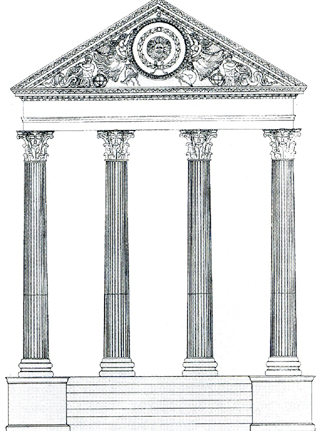|
Roman Temples
The Celts had their own temples and sanctuaries before the Romans came. However the structures built by the Romans to worship their gods (and sometimes Celtic gods too) were far more impressive. They were large, stone buildings with columns, in the Roman style which was borrowed from the Greeks. Unfortunately no Roman temples survive intact in Britain, but we can get an idea of what they were like from archaeology and from temples in good condition in other parts of the Roman Empire.
Roman temples consisted of a rectangular room called the cella, which was a house for the statue of the god. The cella stood on a high platform, or podium. A row of columns created a porch at the front with a flight of steps leading up to it. There may have been columns around the sides too, but stuck onto the wall rather than freestanding.
Plan of the Maison Carree
Members of the public did not enter and worship in congregations, as in modern churches. This took place outside, where animals would be sacrificed on an altar at the bottom of the steps. Inside the cella people could go for private worship, and perhaps to dedicate some small offering to the god. The whole temple area was enclosed by a wall, creating a sort of courtyard.
Romano-British Temples
Another kind of temple was also built, the Romano-Celtic type, for worshipping Celtic gods. These had a square cella (or sometimes they were many sided, like an octagon). There was a covered walkway around the cella. The design may have been Celtic, but the building methods were Roman - the use of stone and brick, painted plaster walls, columns, and stone statues.
Two examples of Roman temples in Britain are the temple to the deified Claudius (the emperor Claudius worshipped as a god) at Camulodunum, and the Temple of Sulis Minerva at Bath. Sulis was a Celtic god and Minerva was the Roman god of war and wisdom. The two were seen as the same god by the Romans. They did this everywhere they went - instead of banning local gods they allowed the people to worship them and identified them with their own gods.
Another example of this is seen at the temple of Apollo-Cunomaglus at Nettleton in Wiltshire. Apollo was the Roman sun god, so Cunomaglus may have the Celtic sun god. The Roman war god Mars was identified with different Celtic war gods, in different parts of Britain - so we have Mars-Toutatis, Mars-Alator, and Mars Lenus. The protector goddess of the Brigantes tribe, Brigantia, was identified with Minerva, as you can see here.
|
Temple to Emperor Augustus, in Nimes, France. From 1st century AD. Now called the Maison Carree.
Model of the Temple of the Deified Claudius, Camulodunum (Colchester)
Map of the excavated area of the Temple of Claudius |
|
The front of the Temple of Sulis-Minerva in Bath |
Carving of the head of Sulis (found at Bath) - shown as a male Celt with moustache and beard, rather than the female goddess Minerva. |
|
Reconstruction of a Roman temple |
Temple of Bacchus (god of wine) at Baalbek, Lebanon
|
|
Temple of Baal Shamin in Palmyra, Syria |
Temple of Roma in Vic, Spain |









